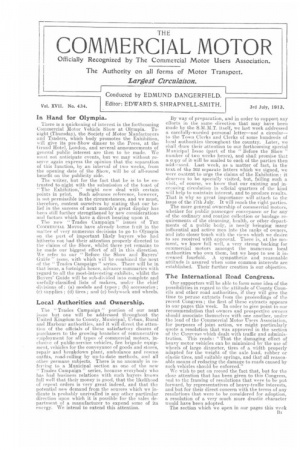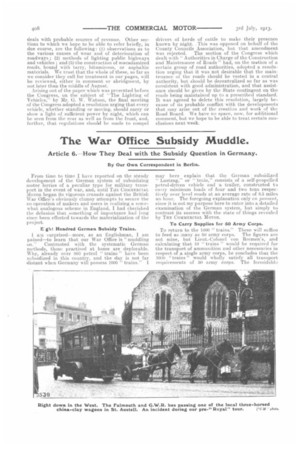In Hand for Olympia.
Page 1

Page 2

If you've noticed an error in this article please click here to report it so we can fix it.
There is a quickening of interest in the forthcoming Commercial Motor Vehicle. Show at Olympia. Tonight (Thursday), the Society of Motor Manfaeturers and Traders, which body promotes the Exhibition, will give its pre-Show dinner to the Press, at the Grand Hotel, London, and several announcements of general public interest are then to be made. We 'mist not anticipate events, but we may without reserve again express the opinion that the separation of this function, by an interval of two weeks, from the opening date of the Show, will be of all-round benefit on the publicity side.
The writer, but for the fact that he is to be entrusted to-night with the submission of the toast of " The Exhibition," might now deal with certain points in print. Such advance reference, however, is not permissible in the circumstances, and we must, therefore, content ourselves by stating that our belief in the success of next month's great display has been still further strengthened by new considerations and factors which have a direct bearing upon it.
The New "Trades Campaign" issues of THE COMMERCIAL MOTOR have already borne fiuit in the matter of very numerous decisions to go to Olympia on the part of important likely buyers who had hitherto not had their attention properly directed to the claims of the Show, whilst there yet remains to be made our biggest, effort of all in this -direction. We refer to our " Before the Show and Buyers' Guide." issue, with which will be combined the next of the " Trades Campaign " series. There will be in that. issue, a fortnight hence, advance summaries with regard to all the most-interesting exhibits, whilst the Buyers' Guide will be sub-divided into complete and usefully-classified lists of makers, under the chief divisions of : (a) models and types ; (b) accessories ; (e) supplies ; (d) tires; and (e) bodywork and wheels.
Local Authorities and Ownership.
The " Trades Campaign " portion of our next issue but one will be addressed throughout the United Kingdom to County, lefunicipal, Urban, Rural and Harbour authorities, and it will direct the attention of the officials of these satisfactory classes of purchasers to the growing branches of remunerative eniployment for all types of commercial motors, inclusive of public-service vehicles, fire brigade equipment, vehicles for the conveyance of goods and storee, repair and breakdown plant, ambulance and rescue outfits, road-rolling by up-to-date methods, and all other germane subjects. There is no anomaly in referring to aMunicipal section as one of the new " Trades Campaign " series, because eveiybody who has had business relations with such buyers knows full well that their money is good, that the likelihood of repeat orders is very great indeed, and that the potential new demand from the sources which we indicate is probably unrivalled in any other particular direction upon which it is possible for the sales departm-ent of a manufacturer to expend some of its energy. We intend to extend this attention.
By way of preparation, and in order to support any efforts in the same direction that may have been made by the &MALT. itself, we last week addressed a carefully-worded personal letter—not a circular— to the Town Clerks and Clerks of some hundreds of loeal authorities throughout the country. Later, we shall draw their atteution to our forthcoming special Municipal Issue (part of the " Before the Show " number of two weeks hence), and shall promise that a copy of it will be mailed to each of the parties then add,Tssed. Last week, as a matter of fact, in the text of the 362 separate letters which we signed, we were coetent to urge the claims of the Exhibition: it deserves to be specially visited, but, failing such a visit, -of course, we know that our existing and increasing circulation in official quarters of the kind will help to maintain interest, and to produce results. That is why so great importance will attach to the issue of the 17th July. It will reach the right parties. The more general ownership of commercial motors, whether for public passenger conveyance or for any of the ordinary and routine collection or haulage requirements of the cleansing, health, or other departments of a public body, is newly bringing many influential and active men into the ranks of owners, and into closer touch with the views which we desire to see received with approval. there is, at the moment-, we know full well, avery strong backing for commercial motors amongst the numerous local authorities who own them, but we hope to see it increased fourfold. A sympathetic and reasonable attitude is assured when some common interests are established. Their further creation is our objective.
The International Road Congress.
Our supporters will be able to form some idea of the possibilities in regard to the attitude of County Councils and other road authorities, if they will give the time to peruse extracts fromthe proceedings or the recent Congress ; the first of these extracts appears in our pages this week. In order to give point to our recommendation that owners and prospective owners should associate themselves with one another, under the lead of the Commercial Motor Users Association, for purposes of joint action, we might particularly quote a resolution that was approved in the section of th.e. Con.F.,:esg which dealt with traffic and administration. this reads: " That the damaging effect of heavy motor vehicles can be minimized by the use of wheels of large diameter, tires of a width properly adapted for the weight of the axle load, rubber or elastic tires, and suitable springs, and that all reasonable means of reducing the damage to roads caused by such vehicles should be enforced."
We wish to put on record the fact that, but for the close attention that has been given to this Congress, and to the framing of resolutions that were to be put forward, by representatives of heavy-traffic interests, and but for their direct concern with the terms of any resolutions that were to be considered for adoption, a resolution of a very much more drastic character would have been adopted. The section which we epen ha our pages this week deals with probable sources of revenue. Other sections to which we hope to be able to refer briefly, in due course, are the following: (1) observations as to the various causes of wear and of deterioration of roadways ; (2) methods of lighting public highways and vehicles ; and (3) the construction of macadamized roads, bound with tarry, bituminous, or asphaltic materials. We trust that the whole of these, so far as we consider they call for treatment in our pages, will be reviewed, either in comment or abridgment, by not later than the middle of August.
Arising out of the paper which was presented before the Congress, on the subject of " The Lighting of Vehicles," by Mr. G. W. Watson, the final meeting of the Congress adopted a resolution urging that every vehicle, whether standing or moving, should carry or show a light of sufficient power by night, which can be seen from the rear as well as from the front, and, further, that regulations should be made to compel drivers of herds of cattle to make their presence known by night. . This was opposed on behalf of the County Councils Association, but that amendment was rejected. The section of the Congress which dealt with "Authorities in Charge of the Construction and Maintenance of Roads" had, on the mi>tion of a certain group of road authorities, adopted a resolution urging that it was not desirable that the maintenance of the roads should be vested in a central authority, but should be decentralized so far as was consistent with good administration, and that assistance should be given by the State contingent on the roads being maintained up to a prescribed standard. It was agreed to delete this resolution, largely because of its probable conflict with the developments that may arise out of the creation and work of the Rued Board. We have no space, now, for additional comment, but we hope to be able to treat certain conclusions next week.


































